Partial mashing is a great method of wort production, but not a lot of homebrew recipes exist for partial mashers to choose from. (This website has quite a few, though.) However, if you’d like to convert an existing extract-based recipe to partial mash, you’re in luck. The majority of extract recipes can easily be converted in two steps. If you have an extract recipe that uses mostly unhopped light malt extract (liquid or dried) — or something similar such as pale or Pilsner malt extract — for most of the fermentables, just follow these following steps. [Read more…]
Partial Mash Option (and ESB Recipe)
 Partial mashing is a method of wort production in which the brewer produces some of his wort from a mash — as an all-grain brewer would do — but supplements it with malt extract. In practice, it is usually used in conjunction with a partial wort boil, so that it is similar to the common malt-extract-plus-steeping-grains method. For extract brewers who don’t have the space for a full all-grain set-up, or outdoor all-grain brewers who occasionally wish to come in from the heat or cold, it is method of brewing that is more flexible — and I would argue produces higher quality beer — than the normal malt-extract-plus-steeping-grains methods. [Read more…]
Partial mashing is a method of wort production in which the brewer produces some of his wort from a mash — as an all-grain brewer would do — but supplements it with malt extract. In practice, it is usually used in conjunction with a partial wort boil, so that it is similar to the common malt-extract-plus-steeping-grains method. For extract brewers who don’t have the space for a full all-grain set-up, or outdoor all-grain brewers who occasionally wish to come in from the heat or cold, it is method of brewing that is more flexible — and I would argue produces higher quality beer — than the normal malt-extract-plus-steeping-grains methods. [Read more…]
BWJ Q and A (Extract Upgrade)

Thanks for the question, Russ. Here’s a picture of two cats hugging a kitten. Or maybe they’re trying to smother him. I don’t know.
I really like your articles and recipes on partial mashing, but my question is which is better, a full-wort boil using extract with steeped grains methods or using partial mash methods without boiling the full wort?
— Russell Albright (Keizer, Oregon)
Stone Ruination IPA Clone (Countertop Partial Mash)
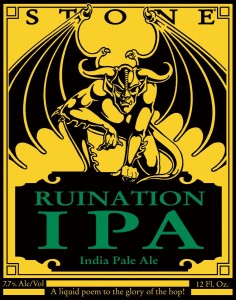 Over the past two weeks, I’ve posted several previously posted recipes reformulated as countertop partial mash recipes. These were: The Cure from Cork (dry stout), Leg of Ordinary Biters (ordinary bitter), Patrick Henry Pale Ale, Amber Socks Red Ale, Roswell IPA and Pharming Polly — a 10-gallon (38-L) stovetop recipe for a Scottish 70/- ale. Previous recipes formulated this way include: Colby House Porter, Fimbulvinter Øl (winter warmer), Beelzeboss (“witbier” brewed with Mt. Dew), and “Freya’s” Eyes (golden ale). This recipe is given for brewers using a 2-gallon (~8-L) beverage cooler as a mash/lauter tun. An option is given for mashing more grains in a 3-gallon (11-L) cooler. There’s also an option to make the double dry-hopped version of this beer.
Over the past two weeks, I’ve posted several previously posted recipes reformulated as countertop partial mash recipes. These were: The Cure from Cork (dry stout), Leg of Ordinary Biters (ordinary bitter), Patrick Henry Pale Ale, Amber Socks Red Ale, Roswell IPA and Pharming Polly — a 10-gallon (38-L) stovetop recipe for a Scottish 70/- ale. Previous recipes formulated this way include: Colby House Porter, Fimbulvinter Øl (winter warmer), Beelzeboss (“witbier” brewed with Mt. Dew), and “Freya’s” Eyes (golden ale). This recipe is given for brewers using a 2-gallon (~8-L) beverage cooler as a mash/lauter tun. An option is given for mashing more grains in a 3-gallon (11-L) cooler. There’s also an option to make the double dry-hopped version of this beer.
This is the last revamped recipe I’ll post for awhile. Going forward, I’ll post countertop partial mash versions of recipes, if people are interested.
Stone Double Ruination IPA Clone
Double IPA
Partial mash (countertop), English units
(all-grain recipe from Mitch Steele, Brewmaster, Stone Brewing Co.)
DESCRIPTION
Described by Stone as, “A liquid poem to the glory of the hop,” Ruination is big, hoppy double IPA with a huge hop aroma. Stone has also released Ruination in a few Double Dry Hopped versions.
Red Ale (Countertop Partial Mash)
Have I ever mentioned how I thought partial mashes are the way to go for stovetop extract brewers? This one has migrated from my brewing notebook to the Easy, Surefire Extract Beers series, and now I’ve reformulated it as a countertop partial mash. Both 2-gallon (~8-L) and 3-gallon (~11 L) mash tun versions are given. This amber ale is full-bodied, with plenty of caramel flavor as well as hop flavor and aroma.
Amber Socks Red Ale
Amber ale
by Chris Colby
Partial mash (countertop); English units
DESCRIPTION
An amber ale with caramel malt flavor and lots of hop flavor and aroma.
Dry Stout (Countertop Partial Mash)
This is my dry stout recipe, formulated for a countertop partial mash. (For more on dry stouts, see the series of articles on that beer style) In this formulation, the brewer mashes 4.0 lbs. (1.8 kg) of grain in a 2-gallon (~8-L) beverage cooler. An option to mash 6.0 lbs. (2.7 kg) in a 3-gallon (~11-L) cooler is also given. In the 2-gallon (~8-L) version, 78% of the fermentables come from the mash. In fact, in both version, all of the malt extract is withheld until the end of the boil.
I have been posting a series of recipes formulated as partial mashes because I feel that partial mash homebrews have more base malt aroma than recipes in which only specialty grains are steeped. If you’re an extract beer thinking of trying all-grain brewing, this is a good recipe to try as the wort is close to being made completely from grains (especially if you try the 3-gallon (11-L) cooler option).
A 1-qt. (1-L) yeast starter is recommended for this beer, but if you get a fresh tube of yeast, you can get away without making a yeast starter.
The Cure from Cork
Dry stout
by Chris Colby
Partial mash (countertop); English units
DESCRIPTION
This is a dry stout reminiscent of Murphy’s Pub Draught, now sold in widget cans. Murphy’s stout is slightly mellower — a little less bitter with a hint of chocolate and caramel in the malt — than Guinness, and (in my opinion) also tastes better when carbonated with CO2, as opposed to pushed with beer gas. If you like session ales — and are disappointed you can’t find Murphy’s except in widget cans — this is a great recipe to try.
Ordinary Bitter (Partial Mash Formulation)
Here is another example recipe using the countertop partial mashing method. This is an ordinary bitter, an English session beer, presented in a 5.0-gallon (19-L) homebrew recipe formulated for either partial mashing with a 2-gallon cooler (main recipe) or a 3-gallon cooler (see option). Compared to a bitter made with an extract-with-steeping-grains formulation, this beer has more aroma from the pale malt. Compared to some other partial mash methods, this uses more grains and less extract. Roughly 70% of the fermentables in this recipe come from the partial mash.
This original version of this recipe appeared in an article about going grain-to-glass in 7 days.
Partial Mash Methods (Countertop Partial Mashing)
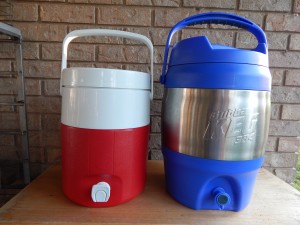
A 2-gallon and a 3-gallon beverage cooler. The 2-gallon (~8-L) cooler can be used to mash 4.0 lbs. (1.8 kg) of grain. The 3-gallon (11-L) cooler can be used to mash 6.0 lbs. (2.7 kg) of grain.
There are many different ways to approach a partial mash. In two previous articles, I discussed the rationale for partial mashing and one method of performing a partial mash — “steeping” the grains in a grain bag, then placing them in a colander over the brewpot and rinsing them. This works well for partial mashes with amounts of grain up to about 4 lbs. (~2 kg). Above that amount, the colander method becomes more difficult. Unless you have an enormous colander, the bag will overflow it and you’re more likely to drip wort everywhere. For larger partial mashes, I like to use what I call countertop partial mashing. Countertop partial mashing uses either a 2-gallon (~ 8-L) or 3-gallon (~11-L) beverage cooler as the lauter tun, the vessel that holds the mash while the sweet wort is separated from the spent grains.
An insulated beverage cooler — the type with a spigot at the bottom, for holding cold or hot drinks at outdoor events — can be used as either just the lauter tun or as both the mash and lauter tun. For coolers up to 5 gallons (~20 L), simply lining them with a large steeping bag is sufficient to separate the wort from the spent grains. (If you want to get fancy, you could install a manifold, as with a full-sized cooler-based lauter tun.) This method delivers between 3 and 4 gallons (~10–15 L) of wort, to which malt extract can be added. This wort can be boiled on a stovetop, the chilled, transferred to a fermenter and diluted with cool water to 5 gallons (19 L) of wort.
Partial Mash Methods (Brewpot Mashing with Colander Lautering)
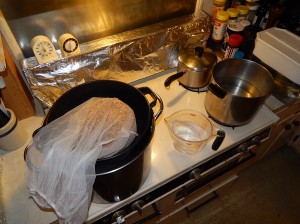
A colander sits above a 5-gallon (~20-L) brewpot. The grains were mashed in the small pot while sparge water heated in the medium pot.
As I mentioned in my previous article, partial mashing provides many benefits, especially for extract brewers. Procedurally, it is very similar to steeping specialty grains — you just need to hold your temperatures and liquid volumes within a certain range. There are a wide variety of ways that homebrewers perform partial mashes. Today I’ll explain one of the most common ways for stovetop brewers to do a partial mash. All you need is a steeping bag to hold the crushed grains and a colander large enough to fit on top of your brewpot. Standard spaghetti-draining-sized colanders will fit over many pots around 5 gallons (~20 L) in volume This method works best for partial mashes with 2–4 lbs. (~1–2 kg) of grain. I’ll explain tomorrow another method for performing larger partial mashes without switching to a full-sized, homebrew mash/lauter tun.
Why Partial Mash? (Mashing vs. Steeping)
I’m a big fan of partial mashing. For all-grain brewers who usually brew outside, it allows you to get out of the elements during inclement weather and brew in your kitchen. For extract brewers, there are a host of benefits.
Adding base malts to your extract recipes increases the aroma of base malt, which is sometimes lacking in malt extracts. And, it allows you to use the many different kinds of base malts out there and base malts made by different maltsters. More ingredients to choose from gives you the opportunity to more finely tweak the flavor of your beers.
A partial mash also allows you brew a lighter-colored beer, compared to the extract-plus-steeping-grains method, if you want to. In addition, if you’re trying to make a dry beer, you can use the enzymes from the partial mash to raise the fermentability of your wort. Finally, you can add small amounts of starchy adjuncts to your beer, without having it turn hazy. Starchy adjuncts include flaked (or torrified) unmalted grains such as flaked maize, flaked barley, flaked wheat, torrified wheat, rolled oats, etc. [The weight of the starchy adjuncts should be 30% or less of the total weight of the grains, excluding any malt extract, and paired with a lightly-kilned base malt with plenty of diastatic power (enzymes to convert starches) such as US 2-row pale malt or US 6-row pale malt.]
A small partial mash can be accomplished almost exactly as you would brew an extract recipe with steeping grains. The only procedural difference is you need to watch the temperature more closely and not “steep” the grains in too much water. It’s hard to think of any drawbacks to the method, although you might generate slightly more break material in your brewpot.
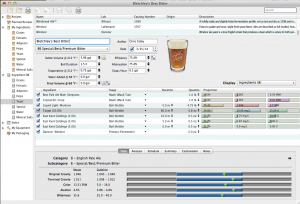
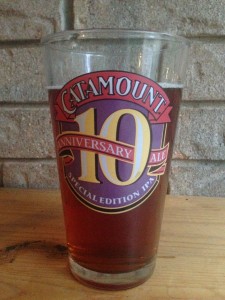

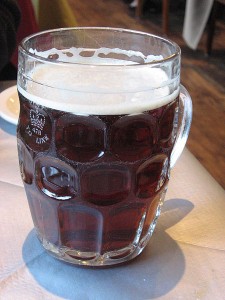
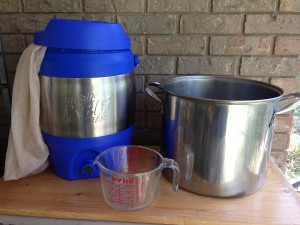

Recent Comments